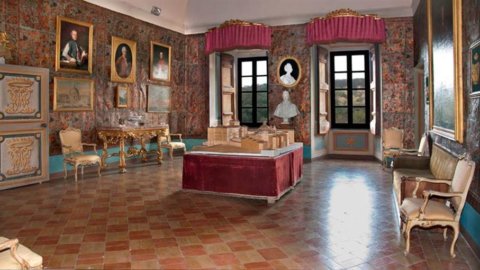The Wonder of the Arts (Rome, 1 April-26 July 2015), the driving force behind a series of initiatives for the enhancement of the historical, artistic and architectural heritage of Rome and its territory: collateral exhibitions, special visits and thematic tours in the most beautiful places of the Roman Baroque , study days, concerts and the historical re-enactment of the Pinwheel of Castel Sant'Angelo.
The exhibition of Palazzo Chigi in Ariccia, curated by Francesco Petrucci, offers works for the most part never exhibited to the public, real portraits and ideal portraits – princes, cardinals and leading personalities of Italian society of the 600s and the first half of the 700s -, as well as philosophers, saints and popular figures.
Among the most significant paintings the San Giacomo Minor by Giovanni Baglione, signed and dated 1626, recently brought to the attention of scholars, whose relevance in the artist's vast production is also documented by preparatory drawings. Of extraordinary pictorial quality the Portrait of an old man by Pietro Paolo Rubens, father of the Baroque, from the National Gallery of Ancient Art in Palazzo Corsini, executed around 1609 immediately after his trip to Italy.
It is of considerable historical and artistic interest Portrait of Father Niccolò Riccardi, known as "Father Monster" by Andrea Sacchi, mentioned by Bellori in the biography of the painter, until now considered lost by critics. Riccardi, Dominican orator and theologian, nicknamed "Padre Monster", both for his physical appearance and for his extraordinary erudition, is best known for the trial of Galileo Galilei. Among the specialists of seventeenth-century portraiture, the exhibition includes painters such as Giusto Sustermans, court artist of the Medici, Giovanni Maria Morandi, official portraitist of the pontificate of Alexander VII Chigi (1655-1667), masters such as Carlo Maratti, Giovan Battista Gaulli and Ferdinand Voet , which held the primacy in Rome in the genre for most of the second half of the 600s. For sculpture, together with the well-known terracotta bust by Mechiorre Cafà depicting Alexander VII, one of the greatest masterpieces of Roman Baroque portraiture, the bust inspired by Bernini depicting Cardinal Leopoldo de' Medici is exhibited, a replica of the Palazzo Pitti version, by to which the attribution to Ercole Ferrata is proposed, which joins the youthful portrait of the Florentine nobleman, before receiving the purple, executed by Sustermans.
Among the ideal portraits a Astrologer philosopher of the currant period of Luca Giordano and a Sant'Andrea attributable to the Venetian stay of the chameleonic artist himself, here particularly influenced by Tintoretto and Titian. It falls under section a Job by Mattia Preti, as well as a spiritual and very delicate one Madonna by Carlo Maratta, who for this specialty was called "Carluccio delle Madonne", as well as a meditative San Giuseppe by Giuseppe Maria Crespi. Of marked sensuality the Portrait of Francesca Gommi, Maratta's lover and later wife, and the Nordic Maria maddalena by the German painter Ignazio Stern.
Two unpublished masterpieces stand out for their quality in the early 700th century portraiture: the sumptuous Portrait of a gentleman by Francesco Solimena, referable to the period of Austrian domination of the viceroyalty of Naples, around 1725-30, and the official version of Portrait of Cardinal Pietro Ottoboni, defined by Francis Haskell “The most adventurous patron of the time”, by Francesco Trevisani.
The review concludes with an intense image of San Filippo Blacks, suspended between ecstatic vision and internalized prayer, by Corrado Giaquinto. Published almost half a century ago in a catalog of the Heim Gallery in London, the painting forms part of Giaquinto's early production, showing, in the cultural hybridization it manifests, the omnivorous sensitivity and absorption capacity of the great Apulian painter.
The exhibition Portrait and Figure from Rubens to Giaquinto boasts loans from authoritative museum institutions, including Palazzo Chigi in Ariccia, the National Gallery of Ancient Art – Palazzo Corsini and the National Academy of San Luca in Rome, as well as private collections, such as The Marignoli di Montecorona Foundation, the Lemme collection and a important English private collection.
The review, organized by the Municipality of Ariccia, is realized with the support of the Roma-Arte-Musei Foundation and The Marignoli di Montecorona Foundation.





